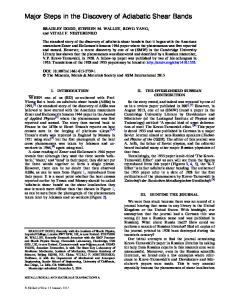Observations on adiabatic shear zones in explosively loaded thick-wall cylinders
- PDF / 2,448,212 Bytes
- 4 Pages / 569 x 813.28 pts Page_size
- 61 Downloads / 271 Views
4800 ~= 1 4 5 0 ) ~ cmZ/sec
0.71) x 10 -~ e x p
[3] T h e A r r h e n t u s p l o t s of t h e m e a s u r e d d i f f u s i v i t y v a l u e s a r e c o m p a r e d in F i g . 4 w i t h t h e r e s u l t s of Arcella and Fitterer 6 who used the galvanostatic m e t h o d , B o t h r e s u l t s a g r e e v e r y w e l l in s p i t e Of t h e d i f f e r e n c e in t h e t y p e o f m e a s u r e m e n t . The error
as bands of intense shear, but conflicting views exist as to the exact nature of their microstructure. Also, it has been postulated that large amounts of austenite (up to 40 pct) would be found at adiabatic shear sites using X-ray diffraction techniques. ~ However, it is generally agreed that the zones are produced by high strain rate loading conditions. During deformation of metals at high strain rates,
limits of the present data are slightly smaller than those of Arcel[a and Fitterer both in activation energy and preexponential factor, as compared with Eq. [4] cited from their unpubiisi~edwork, although the present authors obtain a different equation from their original data, the preexponential term and the activation energy being (5.68 • 0.60) x I0 -s sq cm per sec and 3510 • 2280 cal per mole, respectively. D = (6.53+ 1.15) • I0 -5 exp (
38g0~ • 1 6 7 0 ) c m Z / s e c
(700~ 900~
[41
B o t h s e t s of t h e e x p e r i m e n t a l
d a t a cart b e f i t t e d to
Eq. [5] for the temperature range 700~ to ll00~ sidering the good agreement between the two. D = (6.62 • 0.56) >', 10 -~ e x p
(_3860• ~-~
con-
cmZ/sec
[5] 1. N Sano, S. Honma, and Y. Matsushita: Met. Trans., 1970, vol. 1, p. 301. 2. 3. Crank: The Mathematics o/Diffusion, [J. 45, Oxford UniversilyPress, London, 1956. 3. C. B. Alcock and T. U. Belford: Trans. Farad. Soc., 1964, vol. 60, p. 822. 4. I. F. EU~ottand M. G]eJser: Thercnochemistry for Steetraaking. vol. l, Addison Wesley PublishingCo., Reading, Mass., 1960. 5. W. J. Youden: Statistical Methods for Chemist, pp. 40-49, John Wiley & Sons.New York, 195I. 6. F. G. Arcella aud G R. Fitterer: Universityof Pittsburgh, unpublished research, 1968.
Fig. 1--Adiabatic s h e a r zone along plane of maximum s h e a r , magnification 123 times--airaL
Observations on Adiabatic Shear Zones in Explosively Loaded Thick-Wall Cylinders PETER
A, THORNTON AND
FRANCIS A,t-IEISER
I N a current metallurgical investigation being conducted on thick-wall (4 in. wall--7 in. ]33), low alloy steel cylinders (98 to 127 kg per sq mm yield), subjected to internal explosive loading, adiabatic shear zones have been consistently observed. These zones appeared as distinct bands on the etched surface of polished metallographic specimens, Figs. 1 and 2. They have been described by several investigators x'z PETER A. THORNTON and FRANCIS A. HEISER are Physical Metallurgist and Chief, respectively, Advanced Engineering Section, Benet R & E Laboratories, Watervliet Arsenal, Watervtiet, N. Y. Manuscript submitted December 2, 1970. t496-VOLUME 2, MAY 1971
Pig. 2--Adiabatic s h e a r zone, magnification 520 tir
Data Loading...











